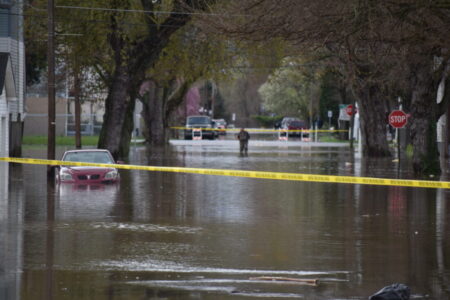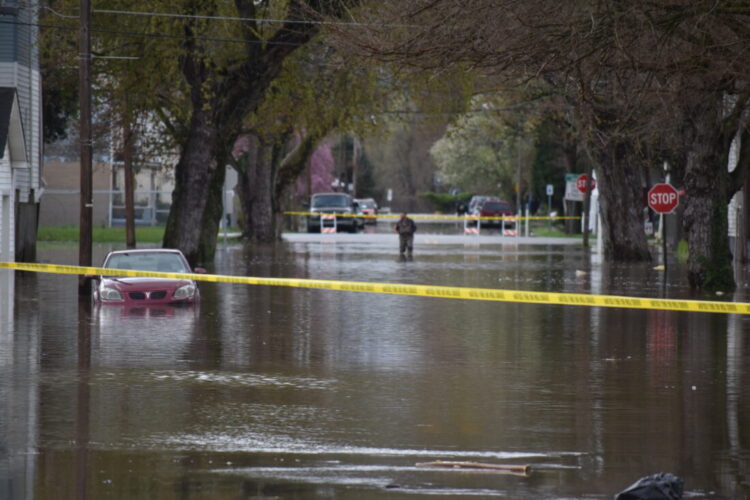
A man wades through waist-high water and vehicle is partially submerged in the middle of South Huron Street on Wheeling Island in April due to Ohio River flooding. (File Photo)
CHARLESTON — More than eight years after catastrophic flooding hit southern West Virginia in 2016 and other flood events across the state since then, West Virginia is close to having an updated flood resiliency plan.
But funding for flood resiliency remains elusive.
The State Resiliency Office (SRO) presented a flood resiliency plan to members of the SRO Board during its quarterly meeting on June 13, ahead of a June 30 deadline required by the passage of Senate Bill 677 during the 2023 legislative session.
Specifics of the new flood resiliency plan were not available, but it is based in part on the work done 20 years ago by state officials on a flood protection plan for West Virginia.
The plan, first begun under Gov. Cecil Underwood in 1998 and completed under Gov. Bob Wise, was never implemented. After a review of the plan was completed by the end of 2022, the SRO told lawmakers it had no plans to update the plan at that time.
“A lot of good folks came together and put that plan together,” said SRO Director Bob Martin during a December 2023 meeting of the Joint Legislative Committee on Flooding. “Everything in it really still holds true today. Those are the things we’re going to be looking at to update and utilize for the plan we’re working on now.”
Now that the state has met the June 30 deadline for the new flood resiliency plan, the SRO is required to conduct annual reviews of the plan completed by June 30 of each year.
“Once we have the review up and an annual update of that plan, every time we go through it and look at it, it is going to be every year, It’s not going to sit on a shelf,” Martin said. “Apparently, that is what happened with the 2004 plan.”
The Legislature created the State Resiliency Office in 2020 thanks to draft legislation by the Joint Legislative Committee on Flooding following numerous issues with the state’s disaster recovery response to the 2016 floods involving federal funds.
On June 23, 2016, the state experienced a 1,000-year flood event that dropped between 8 inches and 10 inches of rain in 12 hours across parts of Fayette, Greenbrier, Kanawha, Nicholas, and Summers counties, killing 23 people and causing more than $1 billion in damage.
In 2020, the Legislature passed Senate Bill 586, which reorganized the former Department of Military Affairs and Public Safety into the Department of Homeland Security, creating the State Resiliency Office. The office was created to work with state agencies to ensure that parts of the state hit with natural disasters and man-made emergencies can bounce back quickly. It also manages non-federal disaster and hazard mitigation grant funding.
Lawmakers further reformed the State Resiliency Office in 2023 with SB 677, bumping up the qualifications to be the state resiliency officer, requiring the officer to have prior experience with developing disaster resiliency plans, community economic development and regional planning. The bill also empowers the officer to hire additional staff as needed and to lead long-term recovery planning efforts in the event of a state of emergency or federal disaster declaration.
The bill gives the state resiliency officer authority over the West Virginia Disaster Recovery Fund previously administered by the Division of Homeland Security. The fund can be used to provide money for disaster recovery for people, local governments, emergency services and local organizations. The bill included $10 million for the fund, which can be replenished each year.
SB 677 also created the West Virginia Flood Resiliency Trust Fund within the State Resiliency and Flood Protection Act. The fund would be used to encourage local governments to work on flood protection and prevention projects. It would prioritize low-income geographic areas and prioritize nature-based solutions — using the local environment and features to protect against flood damage.
However, the Legislature has never appropriated money for the Flood Resiliency Trust Fund. During his eighth and final State of the State address on the first day of the 2024 legislative session, Justice called for a one-time $100 million appropriation, with $50 million set aside for congressional earmarks and $50 million for flood mitigation.
The funding was included in his version of the budget bill — Senate Bill 200 — setting the general revenue budget for fiscal year 2025 beginning Monday, but the funding was stripped out by lawmakers in the version of the budget that passed on March 9.
That version of the budget set the general revenue budget for the next fiscal year at $4.996 billion. While lawmakers traditionally include a section in the budget bill to fund certain items from available surplus dollars at the beginning of the new fiscal year, the Legislature passed a “skinny” budget that stripped out much of the surplus funding, including for flood mitigation.
Justice had called for the $50 million Flood Resiliency Trust Fund appropriation to be included in a May special session to restore various cuts to the budget bill after the state received word from the U.S. Department of Education that the state would receive a waiver from having to spend an additional $465 million on education due to not following federal COVID-19 grant requirements.
Yet, the May special session came and went with no bill to restore the $50 million for the Flood Mitigation Trust Fund. The state is expected to end the fiscal year Monday with nearly $800 million in surplus tax collections, with a special session expected at the end of August to make further supplemental appropriations of those dollars.
“We’ve got to have the ability to have the foresight, especially now, to create a bucket,” Justice said during a press briefing in April. “Absolutely with our surplus dollars we ought to create the bucket and then we’re going to have to continue to replenish the bucket as we go forward.”
West Virginia was also awarded $106.4 million from the U.S. Department of House and Urban Development in Community Development Block Grant-Mitigation funds. The state received the award in 2019, but of the $106.4 million, the state has a balance of $102.8 million as of June 1, having only spent 3.5% of the total award.
The funding is meant for use in Clay, Greenbrier, Kanawha, Nicholas, Fayette, Jackson, Lincoln, Monroe, Pocahontas, Roane, Summers, and Webster counties. The state is also required to use $53.2 million of the CDBG-Mitigation funding in the counties most affected by the 2016 floods — Kanawha, Greenbrier, Nicholas and Clay counties.
HUD requires the state spend 50% of the CDBG-Mitigation funds six years from the date of the execution of a contract with HUD, with 100% of the funds required to be spent in 12 years of the HUD contract.
According to the West Virginia Community Advancement and Development (WVCAD) office, award decisions were made on March 1, 2023. As of June 1, more than $2.5 million has been spent to date from CDBG-Mitigation dollars, with the first funds spent beginning October 2021. That’s far below the $12 million projected expenditures by WVCAD. According to its own timeline, WVCAD expects to spend half of the $106 million grant by January 2026.
According to the Pew Charitable Trust, West Virginia is one of the most flood-prone states in the U.S., with more than 1,600 flood events between 2010 and 2021. With more than 54,000 miles of rivers, creeks, and streams, combined with West Virginia’s mountainous landscape, Pew determined that all 55 counties and 32 watersheds in the state are at flood risk.
Neal Barkus, the president of Conservation West Virginia, has called for nature-based flood mitigation planning as part of the state’s overall flood mitigation plans. In a blog post earlier this month, Barkus called on lawmakers to begin work implementing flood mitigation plans and to provide the needed funding to get started.
“A resiliency plan recognizes the obvious — we are going to have future floods. And because of our warming atmosphere these floods will become more frequent and destructive,” Barkus wrote. “What are our West Virginia Delegates and Senators thinking? Is it going to take more flood disasters, more damage and more deaths before this issue gets on their radar screen?”







